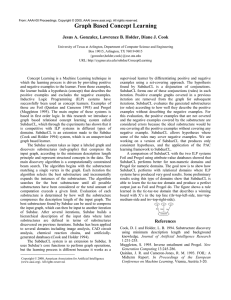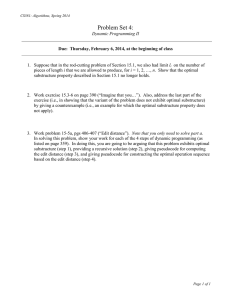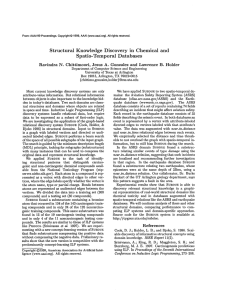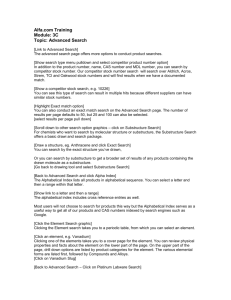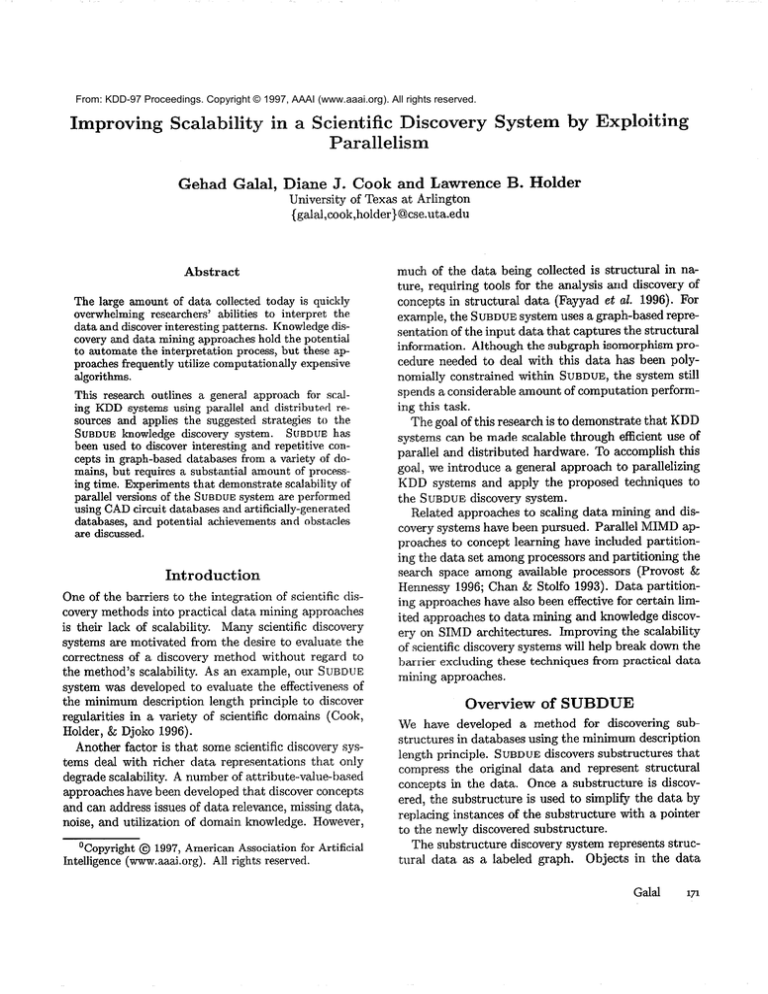
From: KDD-97 Proceedings. Copyright © 1997, AAAI (www.aaai.org). All rights reserved.
Improving
Scalability
Gehad
in a Scientific Discovery
Parallelism
Galal,
Diane
J. Cook and Lawrence
System by Exploiting
B. Holder
University of Texas at Arlington
{galal,cook,holder}@cse.uta.edu
Abstract
The large amount of data collected today is quickly
rwrcm.mrhnlminn
““l.l .“‘Lx,“Y’1’&
rocolrrhara’
‘~UCW~II~I,~
Qhilitinc
u,“#ll”lY”
tn
U” intornrot
‘I~“~~‘y”.‘”
the
data and discoverinterestingpatterns. Knowledgediscovery and data mining approacheshold the potential
to automatethe interpretation process,but these approachesfrequently utilize computationally expensive
algorithms.
This researchoutlines a general approach for scaling KDD systems using parallel and clistribut,erlresourcesand applies the suggestedstrategies to the
SUBDUE
knowledge discovery system. SUBDUE has
been used to discoverinteresting and repetitive concepts in graph-baseddatabasesfrom a variety of dom~;nn
LYcLLlll”, h..+
VU” rom,;wx
r.,.yulrs,”
u.a nrrhct~nt;al
cJ”“O”‘WI”aw
camnrrnt
n,.,\,~occ~..
C”LAA”UI.Y nf
“I yL\‘
.A”m
ing time. Experimentsthat demonstratescalability of
parallel versionsof the SUBDUE system are performed
using CAD circuit databasesand artificially-generated
databases,and potential achievementsand obstacles
are discussed.
Introduction
One of the barriers to the integration of scientific discovery methods into practical data mining approaches
ic:
1a.r.k of
-- their
1----- ------ LsrAn.hilitv.
------dJ
M;l.nvJ scimt,ifir
-_.- -._... _1&XXXT~
systems are motivated from the desire to evaluate the
correctness of a discovery method without regard to
the method’s scalability. As an example, our SIJBDIJE
system was developed to evaluate the effectiveness of
the minimum description length principle to discover
regularities in a variety of scientific domains (Cook,
Holder, & Djoko 1996).
Another factor is that some scientific discovery aysterns deal with richer data representations that only
degradescalability. A number of attribute-value-based
approacheshave been deveioped that discover concepts
and can address issues of data relevance, missing data,
noise, and utilization of domain knowledge. However,
‘Copyright @ 1997,American Associationfor Artificial
Intelligence(www,aaai.org). All rights reserved.
much of the data being collected is structural in nature, requiring tools for the analysis and discovery of
concepts in structural data (Fayyad et a?. 1996). For
-~~~--I-r;ne
L,._ cl
I.__.,.n system
-__^L..- __^^^
____I. L...,,.J __--_
example,
JUBUVB
uses^i* g~apn-~c13~‘
~r;p~rj~
sentation of the input data that captures the structural
information. Although the subgraph isomorphism procedure needed to deal with this data has been polynomially constrained within SUBDUE, the system still
spends a considerable amount of computation performing this task.
The goal of this researchis to demonstrate that KDD
systems can be made scalable through efficient use of
parallel and distributed hardware. To accomplish this
goal, we introduce a general approach to parallelizing
KDD systems and apply the proposed techniques to
the SIJBDUE discovery system.
Related approaches to scaling data mining and discovery systems have been pursued. Parallel MIMD approaches to concept learning have included partitioning the data set among processors and partitioning the
search space among available processors (Provost &
Hennessy 1996; Chan & Stolfo 1993). Data partitioning approacheshave also been effective for certain limited approachesto data mining and knowledge discov“71 In architectures. unprovmg
T---.-.._-.r.e-LL--..I.. I_:,:A.-ery on 3nvru
~nl: acitlaun~y
of scientific discovery systems will help break down the
barrier excluding these techniques from practical data
mining approaches.
Overview
of SUBDUE
We have developed a method for discovering substructures in databasesusing the minimum description
length principle. SUBDUE discovers substructures that
compress the original data and represent structural
concepts in the data. Once a substructure is discovered, the substructure is used to simplify the data by
replacing instances of the substructure with a pointer
to the newly discovered substructure.
The substructure discovery system represents structural data as a labeled graph. Objects in the data
G&l
171
Figure 1: Sample results of Subdue on a protein sequence.
map to vertices or small subgraphs in the graph, and
relationships between objects map to directed or undirected edges in the graph. A substructure is a connected subgraph within the graphical representation.
This graphical repretientation serves as input to the
substructure discovery system. An instance of a substructure in an input graph is a set of vertices and
,%A*,,”c,,,,
----L Al--L
L-L LL-..;.-.I.?...-1
~;uE;~;D
LLUI~ICL,.
tdt: :--..I.
III~UL ~;1ap11
brm _^_I
III~CCII
we grdpmcd
representation of the substructure.
Figure 1 shows a sample input database containing
a portion of a DNA sequence. In this case, atoms and
small molecules in the sequence are represented with
labeled vertices in the graph, and the single and donble bonds between atoms are represented with labeled
edges in the graph. SUBDUE discovers substructure S1
from the input database. After compressing the original database using ,!?I, SIJBDIJE finds substructure 4,
which when used to compress the database further allows SUBDUE to find substructure 5’s. Such repeated
application of SUBDUE generates a hierarchical description of the structures in the database.
The substructure discovery algorithm used by SIJBDUE is a beam search. The algorithm begins with the
substructure matching a single vertex in the graph.
Each iteration the algorithm selects the best substructure and incrementally expands the instances of the
substructure. The algorithm searches for the best substructure until all possible substructures have been
considered or the totai amount of computation exceeds
a given limit. Evaluation of each substructure is determined by how well the substructure cornpressesthe
description length of the database.
Because instances of a substructure can appear in
different forms throughout the database, an inexact
graph match is used to identify substructure instances
with a bounded amount of variation from the suh172
KDD-97
structure definition. A scientist can direct the search
with background knowledge in the form of known substructure models that may potentially appear in the
database! or graph match rules to adjust the cost of
each inexact graph match test. SUBDUE has been
successfully applied to databases in domains including
image analysis, CAD circuit analysis, Chinese character databases, program source code, chemical reaction
chains, Brookhaven protein databases, and artificiallygenerated databases (Cook, Holder, & Djoko 1996).
The results of the scalability study in this paper
are demonstrated on databases in two different domains. The first type of database is a graph representation of CAD A-to-D converer circuit provided by
National Semiconductor containing 8,441 edges and
19,206 edges. The second type of database is an
artificially-constructed graph with 1,000 vertices and
2,500 edges in which instances of a predefined substructure are embedded in a random graph. To test
scalability on larger databases while maintaining the
characteristics of these two domains, we generate multiple copies of the CAD and ART graphs and merge
the copies together by arbitrarily connecting the individual graphs. The terms “n CAD” and “n ART” thus
rofnr
I.II”I
fn
I bly,L”>
rrranh.a
“V w
mwtcictinrr
““111,1”“111~
rrf
“L m
IU marmwl
lllcll6t.,U
c-rm;on
c,“yrb”
nf
“I thn
Loll.2
CAD or ART graphs.
Scaling
KDD
Systems
Making use of parallel and distributed resources can
significantly affect the scalability of a KDD system.
Parallelizing a knowledge discovery system is not easy
because many KDD systems rely upon heuristics and
greedy algorithms to avoid the intractability inherent
irk a>~!t&al.&iye
m-mrnn.chh
-~~-^----. Rnth
1-1--
hmrintirn
------11-“1
nnrl
cwma-lv
-*-- o“~-~
algorithms share the potential of finding a suboptimal
solution and, on closer inspection, a sequentially oriented solution. In many cases KDD algorithms can
perform better if they are provided with enough history of the problem being solved, thus they will perform better in a sequential approach. In addition, the
knowledge discovered in each step by KDD systems depends heavily on what has been discovered in previous
steps. Thus, we cannot decompose the work without
increasing the synchronization and communication between the paraiiei processors.
Two main MIMD distributed memory approaches to
designing parallel algorithms are the functional parallel approach and the data parallel approach. In the
functional parallel approach the algorithm steps are
assigned to different processors, while in a data parallel approach each processor applies the same algorithm
to different parts of the input data.
Dynamic
-4
6
8
10 12
# processors
14
16
Figure 2: Discovery time of 60 substructures in ART.
1 CAD -
2 CAD ----.
3 CAD __....
4 CAD ..._..._.
-4
6
8
10
12
# processors
14
16
Figure 3: Discovery time of 60 substructures in CAD.
F’unctional
Parallel
SUBDUE
The main idea behind this algorithm is to divide S~JBDUE’S search for candidate substructures among processors. The search queue is maintained by one master processor which keeps track of the best discovered
substructures. The master decides whether to keep expanded substructures based on a global evaluation of
discoveredsubstructures. If a slave processor does not
have any substructures then the master asks another
processor to transfer a substructure to the requesting
processor.
Figures 2 through 3 graph the decreasein runtime of
FP-SUBDUE as the number of processorsincreases using an nCUBE 2. The amount of compressionachieved
may also sometimes increase as the number of processors increases. This is due to the fact that the beam
width combined over all processors is greater than a
single beam width on the serial machine, and thus a
greater number of substructures can be considered.
Partitioning
SUBDUE
In the first data partitioning approach, DynamicPartitioning SUBDUE, each processor starts evaluating
a disjoint set of the input data. When DP-SUBDUE
is run, processor i begins processing a candidate substructure corresponding to the ith unique label in the
graph. Each processor receives a copy of the entire input graph and processesa portion of the possible substructures. To prevent work replication, DP-SUBDUE
constrains processorsexpanding a substructure to only
include vertices with a label index greater than the processorID. Load balancing is permitted between processors to prevent excessiving processor idling. The partitions here are logical: the set of all instances of all
the candidate substructures discovered by a processor
constitutes its partition. Quality control is imposed on
the processors in the DP-SUBDUE system by periodically pruning all substructure candidates with values
less than the global average.
Results from the DP-SUBDUE system indicate that
very lim ited speedup can be achieved by distributing
the substructure expansion and evaluation. The work
done to lim it duplicate work and to load balance the
system consumes considerable time in processing and
communication. In addition, the memory requirements
of this data partitioning approach are excessive because the entire database is copied on each processor.
The speedup achieved is very lim ited and the results
are not included in this paper.
Static
Partitioning
SUBDUE
Although the DP-SUBDUE approach was not successful, the data partitioning idea itself is very appealing
in terms of both memory usage and speedup. Here we
introduce a static partitioning parallel approach.
In SP-STJBDUE we partition the input graph into n
partitions for n processors. Each processor performs
sequential SUBDUE on its local graph partition and
broadcasts its best substructures to the other processors. Each processor then evaluates the communicated
substructures on its own local partition. Once all evaluations are complete, a master processor gathers the
results and determines the global best discoveries.
In partitioning the graph we want to balance the
work load equally between processors while retaining
as much information as possible (edgesalong which the
graph is partitioned may represent important information). The Metis graph partitioning package tries to
partition the graph so that the sum of the cut edges
is m inimized. The run time of Metis to partition the
databases is very small (ten seconds on average) and
is thus not included in the parallel run time.
Figures 4 and 5 graph the run time of SP-SUBDUE
G&i
173
ory resources of a network of workstations using communication software such as PVM. The performance
of SP-SUBDUE on a network of 14 PCs also improves
close to linearly in the number of processors.
2500
Conclusions
2
4
6
8
10
12
14
16
# processors
Figure 4: CAD database evaluation time.
The increasing structural component of today’s
databases requires data mining algorithms capable of
handling structural information. The SUBDUE system
is specifically designed to discover knowledge in structural databases. However, the computational expense
of a discovery system such as SUBDUE can deter widespread application of the algorithms.
In this paper, we investigate methods for improving the scalability of scientific discovery methods using parallel resources. When comparing the benefits
of the three parallel applied to SUBDUE, approaches,
DP-SUBDUE is discarded because of poor run time
and heavy memory requirements. FP-SUBDUE can
prove effective in discovering substructures in very
l~rmn
‘aL~.z
2
4
6
8
10
12
14
16
# Processors
Figure 5: ART database evaluation time.
on the CAD and artificial databases as the number of
processors increases. The speedup achieved with the
ART database is always superlinear. This is because
the run time of sequential SUBDUE is nonlinear with
respect to the size of the database. Each processor
essentially executes a serial version of SUBDUE on a
small portion of the overall database, so the combined
run time is less than that of serial SUBDUE.
Increasing the number of processors for the nCAD
and nART databases results in similar quality discovered substructures. As the number of partitions becomes large, the quality of the discovered substructures will decreasebecause some of the edges are cut.
However, with a small number of partitions superior
compression to that of the sequential version can he
realized because the combined beam length is larger
over several processors than for the one processor used
in the serial version of the algorithm.
-^-LlL:
^___A tl,IIlC,Il~
^...^.._ 6116:
Ll. - ~lWCW~.~~
-..DA,.
---,.,. Ah..
-1..L^2..
UW,c1USt:
bllt:
‘,CM,il,
IS
~Ji3,~LlLlWlW
sors, SP-SUBDUE can also utilize the increased mern174
KDD-97
,-lsa+r,h~o,,o
uca~aL,al,~,,
A..,,
uuc
+A
IJ”
:+n
llrU
..,:c..,r,
UluyuG
or\nvnh
3~aAbll
nl n,w.:+hcu~“IICIIIII.
SP-SIJBDUE is the most interesting approach of all by partitioning the database effectively, SP-SUBDUE
proves to be a highly scalable system. One of our
databases contains 2 million vertices and 5 million
edges, yet SP-SUBDUE is able to process the database
in less than three hours. The minimal amount of communication and synchronization that is required make
SP-SUBDIJE ideal for distributed environments. We
have demonstrated the scalability of one KDD system
using these techniques, and will continue to apply the
described methodology to other systems.
Acknowledgements
This research is supported by NASA grant NAS532337 and NSF grant IRI-9502260.
References
Chan, P., and Stolfo, S. 1993. Toward parallel and distributed learning by meta-learning. In Working notes
of the AAAI-93 workshop on Knowledge Discovery in
n-L..a.,.n.^” or)?7
.?A*
uucu”ust;s,
AL I--Le”.
Cook, D. J.; Holder, L. B.; and Djoko, S. 1996. Scalable discovery of informative structural concepts using domain knowledge. IEEE Expert 11(5):59-68.
Fayyad, U. M.; Piatetsky-Shapiro, G.; Smyth, P.; and
Uthurusamy, R. 1996. Advances in Knowledge Discovery and Data Mining. Menlo Park, CA: AAAI
Press.
Provost, F. J., and Hennessy, D. 1996. Scaling up:
Distributed machine learning with cooperation. In
Proceedings of AAAI,
74-79.

